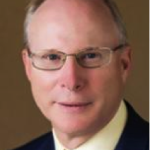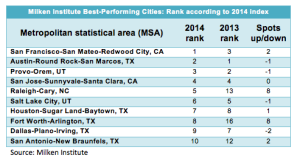
Last Thursday, Ross DeVol, chief research officer at the Milken Institute (MI), came to San Francisco to unveil the findings of the MI annual Best Performing Cities study. The presentation not only set out the rankings of metropolitan areas for 2014, but also addressed the current and projected key drivers and dynamics of job growth.
 California metropolitan areas scored well in the 2014 index. The San Francisco-San Mateo-Redwood City scored at the top of list nationwide (the top 10 listed below), on the rankings combining percentage job growth and wage/salary growth. Three other California metros were in the top 25 list: San Jose-Sunnyvale-Santa Clara at number four, San Diego-Carlsbad-San Marcos at twenty-two and San Luis Obispo-Paso Robles at twenty-four.
California metropolitan areas scored well in the 2014 index. The San Francisco-San Mateo-Redwood City scored at the top of list nationwide (the top 10 listed below), on the rankings combining percentage job growth and wage/salary growth. Three other California metros were in the top 25 list: San Jose-Sunnyvale-Santa Clara at number four, San Diego-Carlsbad-San Marcos at twenty-two and San Luis Obispo-Paso Robles at twenty-four.
 San Francisco metro’s ranking reflects one of the two main job drivers nationwide in 2014: technology growth. San Francisco achieved significant job growth through technology–from 2008-2013 the professional, scientific, and technical services sector created 45% of the 56,100 added jobs in San Francisco. This sector also brought high wage gains–the median wage in San Francisco for workers in this sector was $91,400, 30% above the national median wage in the sector.
San Francisco metro’s ranking reflects one of the two main job drivers nationwide in 2014: technology growth. San Francisco achieved significant job growth through technology–from 2008-2013 the professional, scientific, and technical services sector created 45% of the 56,100 added jobs in San Francisco. This sector also brought high wage gains–the median wage in San Francisco for workers in this sector was $91,400, 30% above the national median wage in the sector.
To an extent, the tech job growth involved established Silicon Valley firms, such as Oracle, LinkedIn, Facebook, that expanded their workforces in San Francisco. To a greater extent, the job growth reflected the tech entrepreneurial frenzy: Dropbox (expanding from 35 employees in 2011 to 5000 in 2013), Twitter (up to 1500 employees from a few hundred), Salesforce, Uber, Quip, Yelp, to name just a few of the tens of major new tech job gainers.
DeVol aptly summarized the San Francisco metro job and wage growth as “fueled by the entrepreneurial ecosystem in social media and mobile apps, cloud-based software and storage, computer systems design, Internet publishing, clean tech biotechnology and medical research—in short the creative and scientific economy.”
The other California cities that made the top 25 rankings were a mix of job sectors and dynamics. San Jose-Sunnyvale-Santa Clara was driven by its technology core (Silicon Valley remains by some distance the largest technology hub in the nation, with 270,9000 employees). San Diego did less well on technology growth, but excelled in job growth in biotech as well as defense. San Luis Obispo-Paso Robles combined tech with growth in agricultural and tourism sectors.
Beyond technology, the second main driver of job growth nationwide was the energy industry, “fueled by technological advances in horizontal drilling and hydraulic fracturing.” The presence of five Texas metros among the top job gainers reflects the role of energy, along with technology: Austin-Round Rock-San Marcos came in at number 2, with Houston, Fort Worth, Dallas and San Antonio metro regions all among the top 10.
One question that arose involved the role of local government in these results. DeVol offered the following explanation: On the role of government in the fast growing cities, entrepreneurship is a key determinate of growth, so that policies that support entrepreneurial efforts are most important. Asking entrepreneurs what they need from government, and building policies from specific needs is criticial.
http://www.foxandhoundsdaily.com/2015/01/californias-job-created-sustained/

